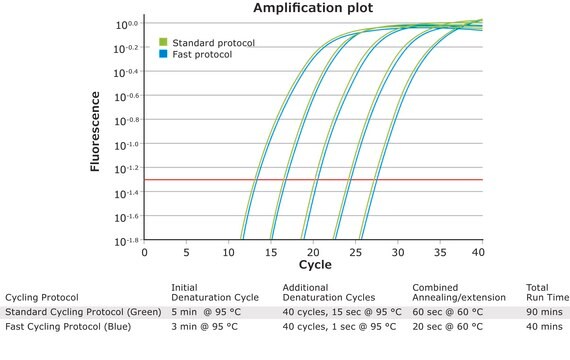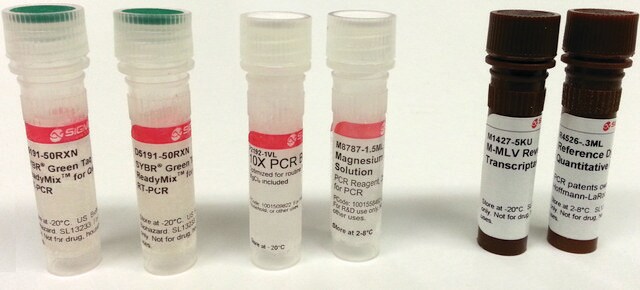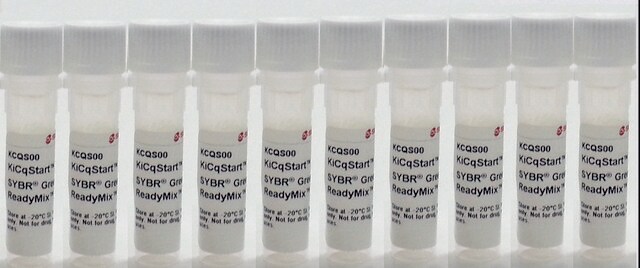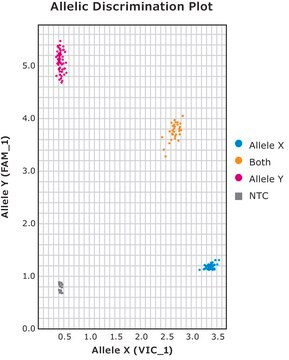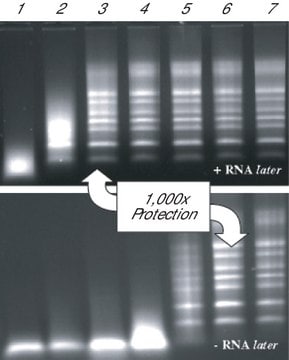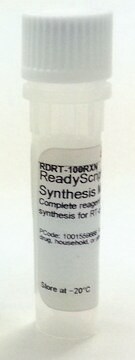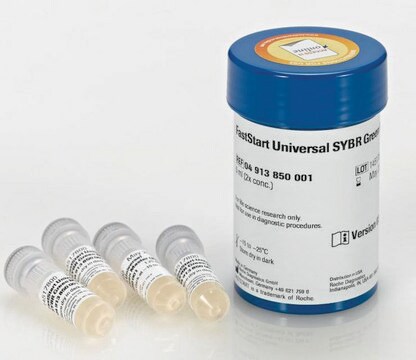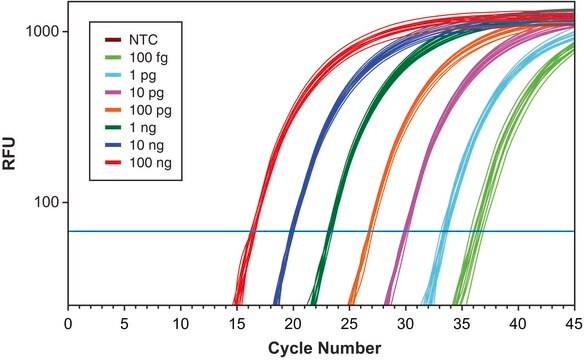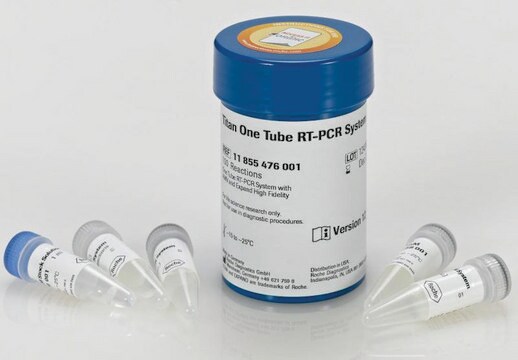Kluczowe dokumenty
SF1UKB
Roche
KAPA SYBR® FAST One-Step
suitable for RT-PCR, 2 ×, Universal
Synonim(y):
SYBR, qPCR
About This Item
Polecane produkty
Poziom jakości
zastosowanie
sufficient for 100 reactions
sufficient for 1000 reactions
sufficient for 500 reactions
okres trwałości
≤6 mo.
Właściwości
dNTPs included: no
hotstart: no
opakowanie
kit of 1 mL (100 x 20 μL rxn; KK4650)
kit of 10 mL (1000 x 20 μL rxn; KK4652)
kit of 5 mL (500 x 20 μL rxn; KK4651)
producent / nazwa handlowa
Roche
stężenie
2 ×
metody
RT-PCR: suitable
qPCR: suitable
moc wejściowa
purified DNA
kompatybilność
for use with Agilent Mx3000P
for use with Agilent Mx3005P
for use with Agilent Mx4000
for use with Applied Biosystems® 5700
for use with Applied Biosystems® 7000
for use with Applied Biosystems® 7300
for use with Applied Biosystems® 7500
for use with Applied Biosystems® 7700
for use with Applied Biosystems® 7900HT
for use with Applied Biosystems® ViiA 7
for use with QuantStudio™
for use with StepOne™
for use with StepOnePlus™
metoda wykrywania
SYBR® Green
temp. przechowywania
−20°C
Szukasz podobnych produktów? Odwiedź Przewodnik dotyczący porównywania produktów
Opis ogólny
KAPA SYBR FAST One-Step qRT-PCR Kits contain M-MuLV reverse transcriptase, RNase inhibitor, and a novel DNA polymerase evolved via directed evolution.
Zastosowanie
- Gene expression analysis
- Low-copy gene detection
- Microarray validationmiRNA research
- Gene knockdown validation
- Real-time quantitative reverse transcription-PCR (qRT-PCR)
- RNAi and miRNA research
Cechy i korzyści
- Consistently higher amplification efficiencies for accurate qPCR.
- Higher fluorescence, earlier Cq values and improved reaction efficiencies.
Amplify across a broad range of target lengths
- Robust performance independent of amplicon size.
- Improve sensitivity and reproducibility
- Accurate interrogation across a wide range of RNA template concentrations.
Quick Notes:
- This kit contains wild-type M-MuLV and an engineered enzyme optimized for qPCR using SYBR Green I dye chemistry.
- The 2X master mix contains a proprietary buffer. Together with the novel enzyme, this improves amplification efficiency of both GC- and AT-rich targets.
- Use only gene-specific primers for one-step qRT-PCR.
- Optimal cDNA synthesis is achieved at 42°C for 5 min.
- 3 min at 95°C is sufficient for RT inactivation and DNA polymerase activation.
- For 3-step cycling, use 20 sec for primer annealing and 1 sec for extension/data acquisition at 72°C.
- Do not exceed 25 μL reaction volumes.
Jakość
Uwaga dotycząca przygotowania
The SYBR Green I dye contained in the KAPA SYBR FAST qPCR Master Mix (2X) and ROX/fluorescein dyes (depending on kit configuration) are light sensitive. Exposure to direct light for an extended period of time will result in loss of fluorescent signal intensity.
KAPA SYBR FAST qPCR Master Mix (2X) is stable through 30 freeze-thaw cycles. Ensure that all reagents are stored protected from light at -20°C when not in use. When protected from light, reagents are stable in the dark at 4°C for at least one week and may be stored at this temperature for short-term use provided that they do not become contaminated with microbes and/or nucleases.
Inne uwagi
Informacje prawne
Tylko elementy zestawu
- KAPA RT Mix
- dUTP
- KAPA SYBR® FAST DNA Polymerase
- reaction buffer
- dNTPs
- SYBR® Green I dye
- MgCl2 2.5 mM
Hasło ostrzegawcze
Warning
Zwroty wskazujące rodzaj zagrożenia
Zwroty wskazujące środki ostrożności
Klasyfikacja zagrożeń
STOT SE 2
Kod klasy składowania
12 - Non Combustible Liquids
Klasa zagrożenia wodnego (WGK)
WGK 1
Temperatura zapłonu (°F)
does not flash
Temperatura zapłonu (°C)
does not flash
Certyfikaty analizy (CoA)
Poszukaj Certyfikaty analizy (CoA), wpisując numer partii/serii produktów. Numery serii i partii można znaleźć na etykiecie produktu po słowach „seria” lub „partia”.
Masz już ten produkt?
Dokumenty związane z niedawno zakupionymi produktami zostały zamieszczone w Bibliotece dokumentów.
Klienci oglądali również te produkty
Produkty
An overview of directed evolution and the methods for generating proteins with optimized or entirely new functions.
Nasz zespół naukowców ma doświadczenie we wszystkich obszarach badań, w tym w naukach przyrodniczych, materiałoznawstwie, syntezie chemicznej, chromatografii, analityce i wielu innych dziedzinach.
Skontaktuj się z zespołem ds. pomocy technicznej